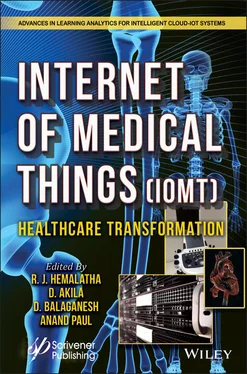The Internet of Medical Things (IoMT)
Здесь есть возможность читать онлайн «The Internet of Medical Things (IoMT)» — ознакомительный отрывок электронной книги совершенно бесплатно, а после прочтения отрывка купить полную версию. В некоторых случаях можно слушать аудио, скачать через торрент в формате fb2 и присутствует краткое содержание. Жанр: unrecognised, на английском языке. Описание произведения, (предисловие) а так же отзывы посетителей доступны на портале библиотеки ЛибКат.
- Название:The Internet of Medical Things (IoMT)
- Автор:
- Жанр:
- Год:неизвестен
- ISBN:нет данных
- Рейтинг книги:3 / 5. Голосов: 1
-
Избранное:Добавить в избранное
- Отзывы:
-
Ваша оценка:
- 60
- 1
- 2
- 3
- 4
- 5
The Internet of Medical Things (IoMT): краткое содержание, описание и аннотация
Предлагаем к чтению аннотацию, описание, краткое содержание или предисловие (зависит от того, что написал сам автор книги «The Internet of Medical Things (IoMT)»). Если вы не нашли необходимую информацию о книге — напишите в комментариях, мы постараемся отыскать её.
Providing an essential addition to the reference material available in the field of IoMT, this timely publication covers a range of applied research on healthcare, biomedical data mining, and the security and privacy of health records.
The Internet of Medical Things (IoMT) — читать онлайн ознакомительный отрывок
Ниже представлен текст книги, разбитый по страницам. Система сохранения места последней прочитанной страницы, позволяет с удобством читать онлайн бесплатно книгу «The Internet of Medical Things (IoMT)», без необходимости каждый раз заново искать на чём Вы остановились. Поставьте закладку, и сможете в любой момент перейти на страницу, на которой закончили чтение.
Интервал:
Закладка:
Since they originate from the bronchi within the lungs, small-cell lung carcinoma (SCLC) and non-small-cell lung carcinoma (NSCLC) are the two main clinic pathological classes for lung cancer. They are also known as bronchogenic carcinomas because they arise from the bronchi within the lungs [4]. Lung cancer is believed to be arising after a series of continuous pathological changes (preneoplastic lesions) which very often discovered accompanying lung cancers as well as in the respiratory mucosa of smokers. Apart from that, the genes involved in lung cancer are epidermal growth factor receptor (EGFR), KRAS, MET, LKBI, BREF, ALK, RET, and tumor suppressor gene (TP53) [5]. The three most common genes in lung cancer are EGFR, KRAS, and TP53, and the structure of these genes is explored in thus study. EGFR is actually transmembrane protein that has cytoplasmic kinase movement and it transduces essential development factor motioning from the extracellular milieu to the cell. According to da Cunha Santos, more than 60% of NSCLCs expresses EGFR which has turned into an essential focus for the treatment of these tumors [6]. In addition, the KRAS mutation is the most widely recognized oncogene driver change in patients with NSCLC and presents a poor guess in the metastatic setting, making it an imperative focus for tranquilize advancement. It is difficult to treat patients with KRAS mutations since there is no targeted therapy yet [7]. Among the mutations, the most common mutation that found to occur in lung cancer is TP53 mutations and its frequency becomes greater with tobacco consumption [8]. In this study, three compounds (curcumin, ellagic acid, and quercetin) were used for docking with the three mutant proteins. Curcumin has excellent safety profile that focus on different infections with solid confirmation on molecule level. Thus, improvement in formulation criteria can aid in developing therapeutic drug [9]. Next, ellagic acid has the ability to bind with cancer cells to make them inactive and it is also effective to resist cancer in rats and mice according to a research [10]. Quercetin is a pigment from plant (flavonoid) which has anti-oxidant and anti-inflammatory effect. It has shown to inhibit the multiplication of cancer cells according to Pao-Chen Kuo et al . [11].
Bioinformatics is a multidisciplinary discipline that creates methods and software tools for storing, extracting, organizing, and interpreting biological data. To analyze biological data, a combination of bioinformatics and computer science, statistics, physics, chemistry, mathematics, and engineering is useful. Currently, this method is growing rapidly because it is cheap and quite faster than experimental approaches. Computational biology tools such as protein modeling (e.g., Swiss Model, Easy Modeller, and Modeller), molecular dynamic simulation (e.g., Gromacs and Amber), and docking (e.g., Autodock version 4.2, AutodockVina, Swissdock, and Haddock) helped design substrate-based drugs to study the interaction between the target proteins (cancer cell proteins) and ligand (phytocomponents).
The aim of conducting this research is to initiate three-dimensional (3D) models of lung cancer line proteins (EGFR, K-ras oncogene, and TP53) and to guesstimate their binding affinities with curcumin, ellagic acid, and quercetin via docking approach.
1.2 Methodology
1.2.1 Sequence of Protein
The entire amino acid sequence of the EGFR (GI: 110002567), K-ras oncogene protein (GI: 186764), and TP53 (GI: 1233272225) were obtained from National Center for Biotechnology Information Center for Biotechnology Information (NCBI). Next, EGFR consists of 464 amino acids, K-ras oncogene protein contains 188 amino acids, while TP53 consists of 346 amino acids.
1.2.2 Homology Modeling
As of now, the 3D models of EGFR, K-ras oncogene protein, and TP53 are not available in Protein Data Bank (PDB). As a result, the models were started with Swiss Model [12] and then visualized with PyMol [13].
1.2.3 Physiochemical Characterization
The physical and chemical characters of the protein structures were analyzed by using the ExPASy ProtParam Proteomics tool [14]. Besides that, hydrophobic and hydrophilic were foreseen by ColorSeq analysis [15]. Furthermore, The ESBRI program [16] was used to reveal salt bridges in protein structures, while the Cys Rec program was used to count the number of disulfide bonds [17].
1.2.4 Determination of Secondary Models
The secondary structural properties were discovered using the Alignment Self-Optimized Prediction Process (SOPMA) [18].
1.2.5 Determination of Stability of Protein Structures
PROCHECK was used to test the protein models [19]. ProQ [20], ERRAT [21], and Verify3D programs were used to conduct further research [22].
1.2.6 Identification of Active Site
The 3D model of EGFR, K-ras oncogene protein, and TP53 were submitted to active site-prediction server [23] in order to discover their binding sites.
1.2.7 Preparation of Ligand Model
The tertiary structure of the quercetin, curcumin, and ellagic acid are not openly accessible. The whole sequence of quercetin, curcumin, and ellagic acid were attained from PubChem, National Center for Biotechnology Information (2017) [24].
1.2.8 Docking of Target Protein and Phytocompound
The 3D structure of EGFR was docked with quercetin, curcumin, and ellagic acid by using BSP-Slim server [25]. In addition, the best docking complex model was chosen based on the lowest binding score. The similar docking method was carried out between the other two protein models and phytocompounds (quercetin, curcumin, and ellagic acid).
1.3 Results and Discussion
1.3.1 Determination of Physiochemical Characters
The isoelectric point (pI) value quantified for EFGR (pI > 7) specify basic feature while the pI for k-ras and TP53 (pI < 7) exhibit acidic. Besides that, the molecular weight of EFGR, k-ras oncogene protein, and TP53 are 50,343.70, 21,470.62, and 38,532.60 Daltons, respectively. The extent of light being by absorbed by protein at a specific wavelength was used to calculate the extinction coefficient of TYR, TRP, and CYS residues where for EGFR is 38,305 M/cm, k-ras oncogene protein is 12,170M/cm, and TP53 is 43,025 M/cm. In addition, –R is the negatively (ASP + GLU) and +R is the positively charged (ARG + LYS) residues in the amino acid sequence. The total of –R and +R for each protein model was described in Table 1.1. According to the instability index of ExPASy ProtParam, EGFR proteins are classified as stable because the instability index for both proteins are less than 40 while K-ras oncogene protein and TP53 is categorized as unstable as the instability index is more than 40. The instability index for EGFR is 35.56, K-ras oncogene protein is 43.95, and TP53 is 80.17. On top of that, the very low grand average of hydropathicity (GRAVY) index (a (negative value GRAVY) of EGFR, K-ras oncogene protein, and TP53 denotes their hydrophilic nature (Table 1.1). Apart from that, EFGR, K-ras and TP53 have more polar residues (41.52%, 53.33%, and 45.29%) than non-polar residues (26.74%, 30.0%, and 27.35%) which were determined using Color Protein Sequence.
Table 1.1Physiochemical characters of EGFR, K-ras, and TP53 proteins as determined by ExPASy ProtParam program.
| Protein | Length | Molecular weight (kDa) | Pl | –R | +R | Extinction coefficient | Instability index | Aliphatic index | GRAVY |
| EGFR | 460 | 50,343.70 | 7.10 | 49 | 49 | 38,305 | 35.56 | 72.91 | –0.269 |
| KRAS | 180 | 21,470.62 | 8.18 | 29 | 31 | 12,170 | 43.95 | 77.18 | –0.559 |
| TP53 | 340 | 38,532.60 | 5.64 | 41 | 33 | 43,025 | 80.17 | 63.99 | –0.592 |
Furthermore, the structure and function of the protein can be affected by salt bridges. Thus, salt bridge disruption minimizes the stability of protein [26]. Next, it is also associated with regulation, molecular recognition, oligomerization, flexibility, domain motions, and thermostability [27, 28].
Читать дальшеИнтервал:
Закладка:
Похожие книги на «The Internet of Medical Things (IoMT)»
Представляем Вашему вниманию похожие книги на «The Internet of Medical Things (IoMT)» списком для выбора. Мы отобрали схожую по названию и смыслу литературу в надежде предоставить читателям больше вариантов отыскать новые, интересные, ещё непрочитанные произведения.
Обсуждение, отзывы о книге «The Internet of Medical Things (IoMT)» и просто собственные мнения читателей. Оставьте ваши комментарии, напишите, что Вы думаете о произведении, его смысле или главных героях. Укажите что конкретно понравилось, а что нет, и почему Вы так считаете.












